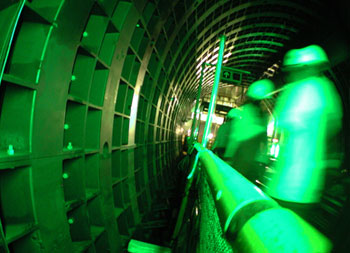Circling beneath Tokyo
The Construction Series > Earthquake >Small > Ginza > Circular > Earth > Underground
The last time the Captain descended Tokyo's depths was when he face-planted the outgoing track of the Hanzomon Line at Shibuya Station one recent Saturday evening.
 This week he's using the stairs. Join him as he journeys through another Tokyo construction project that tunnels its way well beneath the city's surface.
This week he's using the stairs. Join him as he journeys through another Tokyo construction project that tunnels its way well beneath the city's surface.
Soon Tokyoites will be able to drive in circles, and it will be completely intentional.
Deep beneath a boulevard in western Tokyo lies the construction site of the 11-kilometer Central Circular Shinjuku Route - the second link in the Central Circular Route transportation circle.
Planners within the Metropolitan Expressway Company (the project's owner) believe that an efficient road transport system in Tokyo requires a network of expressways in which radial and circular routes work in equilibrium.
The lack of such a system is presently posing tremendous problems.
"Tokyo does not have a completed highway ring at the moment," says Akira Kasuya, a member of the environmental planning department at Metropolitan Expressway. "As a result, Tokyo experiences heavy traffic congestion and economic and environmental deterioration."
The 47-kilometer Central Circular Shinjuku Route is the western link of the second ring of the three concentric circular routes planned for Tokyo. Promoted under the moniker "Tokyo Tunnelix," the project is one of Tokyo's hopes for improvement to the city's traffic woes.
The new link will be comprised of a pair of parallel 12-meter diameter tunnels, one for travel in each direction, bored beneath the north-south running Yamate Dori.
The work uses an earth pressure-balanced shield machine. The spoil generated by the blades and mounted teeth of the rotating shield is removed by belt conveyors. As the work progresses, the back end of the machine jacks consecutive rings of curved concrete segments (10 per ring) inside the tunnel's inner walls to form a lining. The spoil, generated at a rate of 300 tons for each ring, is removed by belt conveyors.
When the boring is finished, the soil between the two tunnels will be removed. A steel and concrete support system in the shape of an "I" beam will be assembled in between to provide strength.
All this digging and lining does not come cheap. Each meter will cost 100 million yen. Japan's Ministry of Land, Infrastructure, and Transport states that this amount is double that of a typical expressway in Japan.
With critics often claiming that many of Japan's road projects are white elephants conceived to appease politically connected construction companies, Kasuya believes this project is different, stating that the benefits of a properly functioning road network outweigh the costs.
"The construction of the Shinjuku link is indispensable," he says. "It's completely different from the 'useless roads' that are talked about."
The Shinjuku-Ikebukuro portion will be opened to vehicles at the end of 2007. Literature provided by Metropolitan Expressway says that when the entire project is finished at the end of 2009, the travel time between the transportation hubs of Ikebukuro and Shibuya from 50 to 20 minutes. At present, approximately 60% of vehicles entering Tokyo from the west transit to the east, creating massive congestion within the city's center. Since this new route will give drivers the option of going around downtown, traffic jams in the capital will be cut substantially.
Citizens in the immediate area will breath a bit easier as well. A circulation system will remove harmful gases from automotive emissions, releasing the filtered air above Yamate Dori via nine ducts. Pumps will send fresh air back into the tunnels. The carbon dioxide reduction is expected to be ten times that absorbed by nearby Yoyogi Park annually.
Surface disruptions are being minimized. The use of the boring machines is intended to reduce the delays and hazards typically associated with road projects.
But conveying the advantages of a mostly hidden project to the public is tricky. The "Tokyo Tunnelix" program last week allowed the media and the general public to descend 30 meters of stairs for tours of the expansive open space that is used to lower equipment and materials.
"The main objective," Kasuya says, "is to spread awareness of the Shinjuku project. We noticed that people hardly knew about it, in spite of it being such a huge project."
A fashion show helped by trying to make construction hip. On the first day of the tour, two-dozen construction workers, attired in helmets and the construction-worker-inspired fashions of German designer Bernhard Willhelm, entertained visitors as they strolled the steel grating inside one of the illuminated tunnels. Visitors on the next day were treated to mannequins - adorned in the very same colorful wear - positioned along the "runway." Booths, staffed by workers from companies performing the work, tried to emphasize that only the latest in construction technology in such fields as excavation and surveying is being implemented.
Approval for the construction of the final 9-kilometer southern link in the Central Circular Route was given in 2004. This project, however, will more than likely not signal the end of road work in Tokyo when it is finished.
Metropolitan Expressway claims that only 20% of the necessary expressways within the metropolis have been constructed thus far. Plans are underway to expand the 85-kilometer outermost concentric ring, which travels through Saitama Prefecture to the north and Chiba Prefecture to the east, with a 16-kilometer segment beginning in Nerima Ward and ending in Setagaya Ward. Tunnels will be used for nine kilometers of the length. The cost will amount to 125 million yen per meter.
Tokyo's apparent motto: Keep on diggin'.
The Construction Series > Earthquake >Small > Ginza > Circular > Earth > Underground

